Vinca minor



Soft wooded
No secondary (woody) tissue being formed. The texture is fleshy and is soft, easy to cut.
Prostrate
Having a low to flattened growth.This prostrate or twinning stoloniferous climber has slender spreading stems that form a dense cover over a large area. It has dark green ovate leaves and the blue-violet trumpet-shaped flowers appear above the foliage from spring to summer.
Vinca minor L. is naturally found from Portugal to France and north to the Netherlands in Europe and extending to the Caucasus and Turkey in south-west Asia. It grows in woodlands, coastal shrubland, river banks and on disturbed soil from sea level to an altitude of 2,300 m (7,500 ft). It has also naturalised in many countries including the United States where it is regarded as invasive. It prefers a well drained poor to fertile moist sandy to loamy or limestone based soil with a pH range from 6.0 to 7.5. It grows in a semi-shaded to sunny, protected position and is frost, drought and very cold tolerant, when protected by snow.
The Dwarf Periwinkle is grown for its spreading habit and flowers. It is planted as a ground cover in parks and gardens or used as a spill-over on embankments or in rockeries. It is also grown in patio pots and planter boxes or used in roof gardens, tolerating neglect. It is planted in alpine gardens and the flowers are used in floral arrangements. There are many cultivars available with varying flower colours but care should be taken in sensitive areas as it can become weedy. It is fast growing and establishes in one season and is moderately long lived and is resistant to rabbits and deer. Once established it has a medium water requirement, (Scale: 2-drops from 3) preferring organic rich moist to dry sandy soil and will tolerate prolonged dry periods.
I.D. 645
UK hardiness zone H6
Climate zones 1 - 24
USDA Zone 4-9
Vinca (VING-ka) minor (Mi-nor)
Etymology
Genus: Latin - Vinca – ‘vincio’ (to bind), referring to the shoots
Species: Latin – minor – smaller, lesser
Cultivars
'Alba'
This plant has white flowers.
'Alba Variegata'
This plant has leaves with pale margins and white flowers.
'Argenteovariegata'
This plant has leaves with creamy white margins and violet coloured flowers.
'Atropurpurea'
This plant has dark plum-purple coloured flowers.
'Azurea Flore Pleno'
This plant has double flowers that are a sky-blue colour.
'Bowles Blue'
This plant has lavender-blue coloured flowers.
'Bowles White'
This plant has pinkish buds that open to white flowers.
'Gertrude Jekyll'
This shrub has a compact habit and blooms in white flowers.
'Multiplex'
This plant has double plum-purple coloured flowers.
Apocynaceae (a-pos-ih-NAY-see-ee)
The plants in this family are well known in domestic gardens (Frangipani, Oleander) and many come from the tropics.
Distribution
These plants come from tropical and limited in warm temperate regions of the world.
Diagnostic Features
These plants may be herbs, climbers, shrubs or trees.
The leaves are simple and arranged opposite, sometimes alternate or whorled.
The sap is normally milky-latex type.
The regularly symmetrical flowers occur in cymes and are bisexual. They are fragrant and have five sepals that are fused onto a tube, five petals that are fused into a tube towards the base and are funnelform to salverform shape. There are 5 stamens that are inserted in the corolla tube and have anthers on top that are united to the style.
The half inferior to superior ovary has one to two chambers, which have two or more ovules.
The fleshy fruit is capsular or a follicle when paired.
The flat seed are normally hairy with a straight embryo that may have an endosperm.
Note:
Australian aborigines eat the fruit of Carissa spp and used the wood for spear making. Some species are used for herbal medicines and the latex has some commercial importance.
This plant tolerates between USDA zones 4a to 9a and grows to 0.2 m (8 in)
Fahrenheit -30º to 30º F
These temperatures represent the lowest average.
Celsius -34.4º to -1.2º C
Attention
All photographs and data are covered by copyright. Apart from any fair dealing for the purpose of private study, research, reference or review, as permitted under the Copyright Act, no part may be reproduced by any means with out written permission. All inquiries should be addressed to plantfile.com attention Peter Kirkland.

Simple
The leaf that is not divided.
Elliptical
A leaf that tapers equally at both ends. Broadest at the middle.
Opposite
Leaves that are arranged opposite to each other.
Entire
A leaf margin with no irregularities (smooth).The 40 mm (1 5/8 in) long leaves are elliptical to oblong or ovate with an acute apex and a rounded base with a petiole up to 30 mm (1 ¼ in) long. It has a dark green waxy upper surface and is pale green beneath. The margins are entire unlike the margins of Vinca major which are ciliate, (fine hairs).

Salverform
Salver (a tray). A flower with a tubular base and open flat petals.
Solitary
When a flower that arises singly from within the axis of a leaf or terminally.| Jan | Feb | Mar | Apr | May | Jun |
| Jul | Aug | Sep | Oct | Nov | Dec |
The 30 mm (1 ¼ in) wide salverform flowers are held above the foliage on a slender pedicle that is up to 30 mm (1 ¼ in) long. The colour in the cultivars ranges from purple to white and the flowering period is from spring to early summer and sporadic throughout summer in warm zones.

Follicle
A capsular fruit that splits open down one side only and normally contains one seeds. "| Jan | Feb | Mar | Apr | May | Jun |
| Jul | Aug | Sep | Oct | Nov | Dec |
The 50 mm (2 in) long slender cylindrical follicle contains 3 - 5 seeds that have no endosperm and are released when the follicle dries and splits. The small seeds are viable but the plant is commonly reproduced vegetatively.
The Dwarf Periwinkle is grown for its spreading habit and flowers. It is planted as a ground cover in parks and gardens or used as a spill-over on embankments or in rockeries. It is also grown in patio pots and planter boxes or used in roof gardens, tolerating neglect. It is planted in alpine gardens and the flowers are used in floral arrangements. There are many cultivars available with varying flower colours but care should be taken in sensitive areas as it can become weedy. It is fast growing and establishes in one season and is moderately long lived and is resistant to rabbits and deer.
Note:
This plant is susceptible to Fuller's Rose Weevil.
Divide established clumps from autumn to spring. Take semi-hardwood cuttings during summer.
Asexual Propagation (Cuttings general)
Propagation from cuttings is possible because every cell of a plant containers the genetic information to create an entire plant.
1. Reproduction occurs through the formation of adventitious roots and shoots.
2. The uniting of vegetative parts with budding and grafting.
3. Taking stem cuttings and layering is possible due to the development of adventitious roots
4. Root cuttings can form new shoots then it is possible to join roots and shoots to form a new plant.
5. A new plant may be formed from a single cell in an aseptic culture system, (cloning).
It is important to propagate vegetatively as this form of cloning retains the unique characteristics of the cultivars or where particular aspects of a plant may be lost if propagated by seed.
Equipment Required for Taking Cuttings
1. A sharp knife that is not too large or a razor mounted in a handle.
2. Good pair of sharp secateurs that is clean.
3. A dibbler to make a hole in the media and allow the cutting to be placed in.
4. Propagation structures that are either a timber frame with glass or polyethylene cover or a glasshouse.
The object of the structure is to create an environment where the temperature and humidity can be controlled. This can be achieved with a simple cover over a pot with a wire frame and plastic.
This stops the draughts and maintains humidity.
5. A hotbed is a useful item as many plants root more quickly if the media is slightly warmer.
Bottom heat is obtained from thermostatically controlled heating cables that are running under the media.
6. Misting systems are of great benefit to cuttings as the regulated fogging with water inhibits the cuttings from drying out and as a result the cuttings may be grown in full sun.
This results in faster root development that is less subject to diseases by fungi and bacteria.
7. Rooting mediums
The rooting medium must be well drained, sand may be used as long as it is thoroughly washed and leached of all salts. It is very well drained and it is excellent for cutting that root up quickly. Equal parts of sand and peat moss have good results for cuttings, which are left for a period of time to allow the roots to form.
Vermiculite and perlite are also used as a well-drained rooting media but has the same disadvantage as sand having no nutrients. The cuttings must be potted up as soon as the roots developed, or a light application of liquid fertiliser can be applied.
Types of Cuttings
Stem cuttings
These are the main types of cuttings.
1. Softwood cuttings
These cuttings are taken from young growth on side shoots and tip growth.
2. Semi hardwood cuttings
These cuttings are taken from wood that is firmer and semi ripe usually during mid summer.
3. Hardwood cuttings
These cuttings are taken from mature wood normally towards the end of the season.
4. Root cuttings
Cut sections of roots to obtain new plants during late winter to early spring.
5. Leaf cuttings
Cut the leaf blade in order to obtain new plants during the growing period of the plant.
Cutting preparation
Hardwood cuttings
When taking hardwood cuttings remove the leaves and in semi hardwood reduce the number of leaves by half. Cut the wood straight across just below a node or joint. Hardwood cuttings are normally between 100 to 760 mm (30 in) long and may have either a heel of the older wood attached to the base, or a short section of the older wood at the base. These cuttings are prepared during the dormant season from late autumn to early spring and are made up from previous season's growth.
This type of cutting is used for woody deciduous plants such as Crepe Myrtle, Rose rootstocks and some fruit trees.
The cuttings should be healthy wood with ample supply of stored food as to nourish developing roots, shoots and placed in the rooting media with the aid of a dibbler stick.
Softwood cuttings
The cuttings for softwood should be 60 to 130 mm (5 1/8 in) long and be of material with enough substance as to not deteriorate before the new roots appear. Cut below a node and retain the leaves on the upper portion. Place in a well-drained media and maintain a high humidity.
Soaking the cuttings and leaving them standing in water for long periods is undesirable.
Herbaceous cuttings
These cuttings are taken from succulent plants such as Geraniums and Coleus. The cutting should be 70 to 130 mm (5 1/8 in) long with leaves retained on the upper end. As in softwood cuttings these require an environment of high humidity. Some fleshy cuttings ooze sap and may require a drying period for a few hours before being placed in the rooting media.
Leaf cutting
In these cuttings a leaf blade and petiole or part off is used to raise a new plant. The original leaf doses not become a part of the new plant as roots and shoots appear from the base of the leaf. In some cases roots appear from the severed veins.
Leaf-Bud cuttings
These cuttings incorporate a leaf, petiole and a small piece of the stem. These cuttings are an advantage where the plant uses the axillary bud at the base of the petiole for new shoot growth and maximises available propagation material, as each node will produce a new plant.
As in softwood cuttings these require an environment with high humidity and warmth.
Root cuttings
These cuttings are best taken from younger plants during late winter to early spring prior the new season's growth unless the dormant period is during summer.
Trim the roots as they are dug up, to maintain polarity cut strength at the crown end and a slanted cut at the distal end (away from the crown).
Root cuttings of small plants are placed in flats in lengths of 20 to 50 mm (2 in) and laying horizontally on the surface of the soil. These may be lightly covered with sieved sand or media, watered and then placing a piece of glass or polyethylene over the container till roots / shoots appear.
Fleshy Root cuttings
These cuttings should be 50 to 75 mm (3 in) long and placed vertically in a well-drained sand media.
Keep the polarity correct and when the roots develop transplant the cuttings into a separate container.
Large Root cuttings
These cuttings are 50 to 150 mm (6 in) long are tied up in bundles and placed in boxes of damp sand, sawdust or peat for about three weeks at a temperature of 4. 5 deg C. When taken out they should be planted in a prepared bed 50 to 80 mm (3 1/8 in) apart with the tops of the cuttings level with or just below the soil level.
Crown Division (General)
The crown is the part of the plant at the surface of the soil where new shoots arise. With lateral shoots the crown of some plants requires division when they become crowded.
Herbaceous perennials and multi-branched woody shrubs may develop large crowns that need dividing.
It is a simple method of propagation that is used by amateurs and professionals for a small increase in plants.
Plants that flower during spring to summer are divided during autumn and if flowering in summer to autumn they are divided in spring. The crown is dug up then cut with a knife in to sections, which has a shoot and abundant roots then planted or potted up. The crown may also be divided in some species by using a shovel to cut and dig sections out.
PEST
NAME
Aphids
Various Aphid Species
ORDER
Hemiptera
FAMILY
Aphididae
Description of the Pest
The common name varies and aphids may be referred to as black fly, greenfly, ant cows or plant lice.
These small insects have soft globular body that is from 1mm to 8mm long and vary in colour from green, yellow, black and pink, with the winged forms being elongated. Both adult and nymphs, have piercing and sucking mouthparts.
Aphids are found on buds, flowers, or leaves and stems, preferring soft new growth. On older leaves the aphids are found in protected positions, such as under the leaf. Certain species of aphids form galls as they suck sap and may be found on the roots of the plant. (E.g. Woolly aphids and Black peach aphids)
Most aphids possess a pair of characteristic tubular projections, known as cornicles; these secrete a pheromone and a waxy fluid, which is thought to protect them from some of their predacious enemies.
White exoskeletons, honey dew and sooty mould indicate the presence of Aphids
Balsam Twig Aphid (Mindarus abietinus) is greenish and covered in a white wax and is normally found on the young shoots of conifers bending and killing the needles. It is found on Abies and Picea species.
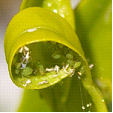 Aphid and their exoskeletons
Aphid and their exoskeletons 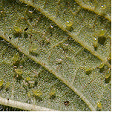 on underside of a leaf
on underside of a leaf
Black Citrus Aphid (Toxoptera aurantii) has a soft plump green body and the black coloured adults may or may not be winged. They feed in groups, curling leaves and producing honeydew attracting sooty mould.
Green Peach Aphid (Myzus persicae) is a soft plump green insect up to 0.2mm long and may be wingless. The nymphs are yellowish green and are responsible for spreading viruses in Dianthus species.
Spruce Gall Aphid (Chermes abietis) form cone shaped galls up to 12mm long resulting from the feeding. The wingless female adult lays eggs on the stems and the immature females overwinter on bud scales. Large infestation will weaken trees such as Picea abies and Pseudotsuga menziesii.
Tulip Bulb Aphid (Anuraphis tulipae) is small, waxy grey coloured and infests the underside of the bulb scales or rhizomes. They occur in the ground or on above ground parts and during storage.
Life Cycle
These insects have a Hemimetabolous life cycle, i.e. The nymphs resemble the adults.
During spring all eggs produced hatch as female nymphs. Adult Aphids are capable reproducing without fertilisation. The males are only produced in some species as the weather cools down, and the day length shortens.
Aphids are capable of giving birth to living young and large populations build up quickly during summer. Over crowding causes the aphids to become smaller, less fertile and produce more winged forms that can migrate to other host plants.
There are many different types of aphids and the life cycle varies from warm to cold climates.
Typical life cycles

Distribution of the Pest
World wide
Period of Activity
In warm climates they are seen throughout the year, but aphids dislike hot dry or cold conditions and heavy rain will decrease the population. In cold areas aphid eggs are laid around a bud base or other protected areas of the plant during autumn and emerge as nymphs during spring, feeding on the new growth.
Numbers build up quickly in the warmer months of the year. Some species feed during winter on Sow thistles.
Susceptible Plants
There is a wide range of plants attacked, from roses to vegetables, shrubs and trees. Certain aphids attack a specific genus while others have a wide range of host plants. Many are capable of transmitting plant virus diseases.
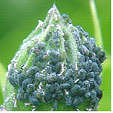 Adults and nymphs feeding
Adults and nymphs feeding 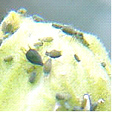 A colony of aphids
A colony of aphids
Acer species are attacked by several aphids including the Norway Maple Aphid (Periphyllus lyropictus) which is a greenish with brown markings and secret honeydew, preferring Acer platanoides. Other aphids include (Drepanaphis acerifolia) and (Periphyllus aceris) which are commonly found on the underside of leaves.
Acer species are also attacked by the Woolly Maple Aphid (Phenacoccus acericola) which covers the undersides of the leaves with a cotton-like mass
Alnus species are infested with the Alder Blight Aphid (Prociphilus tessellates) which is blue-black adult that forms woolly masses on the down-turned leaves. The nymphs overwinter in bark crevices.
Aquilegia species are attacked by several aphids including (Pergandeidia trirhoda) which is a small, flat cream coloured insect that is found on young branches and the underside of leaves.
Betula species may be attacked by the European Birch Aphid (Euceraphis betulae) which is small and yellowish or the Common Birch Aphid (Calaphis betulaecolens) which is large and green producing ample honeydew for sooty mold to grow on.
Callistephus species may be attacked by the Corn Root Aphid (Anuraphis maidi-radicis) causing the plant to become stunted, the leaves wilt and turn yellow. The aphids feed on the roots producing honeydew and are dispersed to other host by ants. It is also attacked by the Potato Aphid (Macrosiphum solanifolii).
Carya species are attacked by Gall Aphids (Phylloxera caryaecaulis) which is found on the leaves, twigs and stems forming galls and turning them black.
Chaenomeles and Gladiolus species, new growth and leaves become infested with the aphid (Aphis Gossypii)
Cupressus macrocarpa may become infested with the Cypress Aphid (Siphonartrophia cupressi).
Cyclamen species are attacked by the aphid (Myzus circumflexus) and (Aphis gossypii) which can infest healthy plants.
Dendranthema, Dianthus and Crocus species are attacked by several types of aphid including the Green Peach Aphid (Myzus persicae) and the Chrysanthemum Aphid (Macrosiphoniella sanborni).
Hibiscus species are attacked by the aphids (Aphis craccivora) and (Aphis gossypii), both congregate towards the branch tips and may cause leaf curl. Normally only seen in sub-tropical climates.
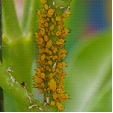 Aphids on a stem
Aphids on a stem 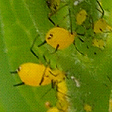 Mandevilla species
Mandevilla species
Larix species is attacked by the Woolly Larch Aphid (Adelges strobilobius). The winged adults deposit eggs at the base of the needles during spring and white woolly areas appear attached to the needles where the adult aphids feed. The young aphids overwinter in the crevices of the bark.
Mandevilla species is attacked by aphids that congregate towards the branch tips and may cause leaf curl.
Pinus species is attacked by several species of aphid including Pine Bark Aphid (Pineus strobi), Pine leaf Aphid (Pineus pinifoliae) and the White Pine Aphid (Cinara strobi).
Primula species are attacked by four species of aphid including foxglove, and green peach aphid.
Rudbeckia, Delphinium, Chrysanthemum and Helianthus species are attacked by a bright red aphid (Macrosiphum rudbeckiae).
Sorbus aucuparia is affected by the Rosy Apple and Woolly Apple aphid which attacked the foliage and young shoots.
Spiraea species are attacked by the Aphid (Aphis spiraecola) which feeds on the young shoots and flowers.
Tropaeolum species are attacked by the Black Bean Aphid (Aphis fabae), which is found in large numbers on the underside of the leaves, turning them yellow and causing them to wilt then die.
Tulipa, Iris, Freesia, Gladiolus and Zephyranthes species are infested with the Tulip Bulb Aphid.
Ulmus species are infected by two types the Woolly Apple Aphid (Eriosoma lanigerum), which curls and kills young terminal leaves and the Elm Leaf-Curl Aphid (Eriosoma ulmi) which occasionally attacks the trees.
Viburnum species are attacked by the Snowball Aphid (Anuraphis viburnicola). This aphid congregates at the end of the branches causing the leaves to curl and become deformed under which they hide.
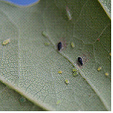 Aphids on Quercus robur
Aphids on Quercus robur
Damage Caused
Buds that have been attacked may not open, leaves and twigs become twisted or distorted and wilt. The aphids also produce honeydew, which is sticky and attracts sooty mould (fungus). This fungus forms a thick layer over the leaf, fruit or stems reducing the plants photosynthesis capability. The sooty mould spoils the plants appearance and its fruit, as does the insects white exoskeletons.
Control
Cultural Control
Aphids may be removed from a plant by hosing them off with water (limited success) or applying soapy water to aphids.. Another organic sprays can be efficient in controlling aphids. Aphids may also be removed physically by hand for small colonies on spine less plants. Species that live under ground are difficult to control but cultivation of the surrounding soil may help in controlling the infestation. (limited mainly to annual or commercial crops)
Reflective mulch around the plants also reduces numbers by repelling the insect this material is available commercially. (Reflective mulches are mainly used in market gardens for avoiding the Green peach Aphids) Resistant rootstocks are available to avoid some root feeding aphid of commercial plants, e.g. Vines and fruit trees
Biological control
Aphids are attacked by several insects includes parasitic wasps or predators such as ladybirds/ lady beetles, hover flies, lacewings, spiders.
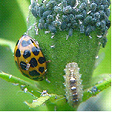
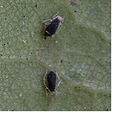 Parasitised aphids
Parasitised aphids
Chemical Control
Aphids may be controlled by spraying with a contact or systemic insecticide. The type of application used will depend on the plant is being attacked.
Aphids can be suffocated and therefore controlled with the use of e.g. White oil, Pest oil, Soapy water from soap such as Lux Flakes ®
Note
It is your responsibility by law to read & follow the directions on the label of any pesticide
Monitoring
Aphid are attracted by yellow colour and traps such as boards painted yellow and covered in glue or sticky substance will attract and trap the insects. There is also a commercially sticky yellow tape that can be attached to susceptible plants
Amendments by B. Sonsie Dip Hort Sc Burnley
PEST
NAME
Leaf Hopper (General)
Various Leaf Hopper Species
ORDER
Hemiptera
FAMILY
Eurytomidae
Description of the Pest
Generally hopper grows up to 15mm in length, with "A"-shaped folded wings that give it a characteristic triangular cross-section. The adults often have bright coloured markings and the nymphs conjugate in colonies. Adults can fly but will hop away immediately if disturbed and both nymphs and mature hoppers have piercing and sucking mouth parts.
The Passion Vine Hopper (Scolypopa australis) has clear triangular wings that have brown margins and black bands. The nymphs are wingless and white with tufts of hair on the end of the abdomen.
The Green Leaf Hopper (siphanta acuta) looks triangular with its steeply folded wings and can grow to 10mm long. The adults are generally a solitary feeder but the nymphs congregate on shoots.
Appearance and Distribution of the Pest
The adults and nymphs are present throughout the year in tropical to warm temperate regions and are dispersed by flying.
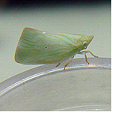

Life Cycle
These insects have a Hemimetabolous life cycle, ie. When the immature nymphs resemble the adults.
Females deposit eggs in slits they make in the bark or on the leaves of the host, and several generations may appear annually on the same plant.
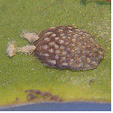 Egg and Nymph
Egg and Nymph 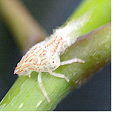
Damage Caused
Nymphs and adults are gregarious, and both stages may be found on host plants at the same time. If large numbers attack young new growth, sucking sap from leaf petioles and young stems, the host plant may become stressed. Severe infestations may weaken and eventually kill the plant with dieback and distorted leaves.
The nymphs exude a sweet secretion, which is attractive to ants that attend and protect the colony. The honeydew also causes sooty mould to occur as a secondary problem. Some species produce toxic saliva that kills the effected plant tissue; other species carry plant viruses.
Susceptible Plants
Most Eucalyptus, Acacia and Casuarina species are attacked by a variety of leafhoppers. Many other Australian native and ornamental plants are attacked.
Acer species are attacked by the leaf hopper (Alebra albostriella) which lays eggs under the bark causing minor swelling. Acer platanoides is particularly venerable.
Callistephus and Aster species are attacked by the Leaf Hopper (Macrosteles fascifrons) that generally causes little harm to the plant but transmits Yellow Disease, a viral infection.
Fern species are attacked by several types of leaf hopper, particularly the Passion Vine Hopper (Scolypopa australis). New fronds become deformed or misshapen as the insect sucks the sap causing dead patches to appear.
Parthenocissus species are attacked by the Green Leaf Hopper.
Rosa species are attacked by the Rose Leaf-hopper (Edwardsiana rosae), nymphs feed on the underside of leaves causing white blotches.
Sorbus aucuparia is attacked by the Japanese Leaf Hopper (Orientus ishidae) which causes the leaves to form a brown blotches with yellowish margins.
Cultural Control
Improving the culture of the host species may assist in maintaining vigorous growth, to minimise shock from infestations. It may be possible to remove them by hand, from young trees, using a small butterfly net if you are lucky.
Biological Control
Controlled by natural predation and the Green Leaf Hopper causes little harm and control is unnecessary.
Chemical Control
Under normal circumstances, it is impractical and unnecessary to treat mature trees however, hoppers on young plants may be treated with a contact insecticide. Note
Always read the label for registration details and direction of use prior to application of any chemicals.
PEST
NAME
Scale Insect
Various Scale Species
ORDER
Hemiptera
Description of the Pest
Generally scales are soft bodied insects that have a hard (armoured) or soft covering to hide under. They have piercing and sucking mouth parts that are attached to the host, feed off sap and soft scales commonly producing sweet honeydew, which in turn attracts sooty mould and ants.
The adult female has a circular or oval covering depending on the species and is up to 8mm across. The first stage (crawlers) hatch and wander around the leaf surface until finding a suitable place to suck sap, normally in colonies and the smaller male is relatively inconspicuous.
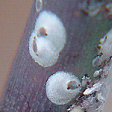 Hard Scale
Hard Scale 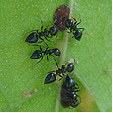 Soft Scale, attending Ants
Soft Scale, attending Ants
Cactus Scale (Diaspis echinocacti) has a circular greyish female and a narrow white male scale and is commonly found on house plants.
Chain Scales (Pulvinaria species) adult females are obvious with large group of eggs that are white or cottony-like, and the tiny young light green scales are flat and oval-shaped up to 2mm long. The legged nymphs are normally arranged from head to tail along the mid rib of the leaf, and may move to a new position to feed. They excrete honeydew and attract sooty mould and are found on Acacia and Acronychia species.
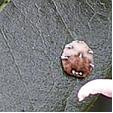 Chinese Wax Scale
Chinese Wax Scale
Chinese Wax Scale (Ceroplastes sinensis) is a domed wax scale that has dark spots around its margin and immature scales form waxy material around there margins.
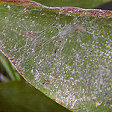 Fern Scale on Aspidistra elatior
Fern Scale on Aspidistra elatior
Fern Scale or Coconut Scale (Pinnaspis aspidistrae) appears as flecks up to 0.15mm long with a white covering over the male congregating on the underside of the fronds on the axils and among the sporangia causing them to turn yellow. Many species of fern are susceptible to infestation.
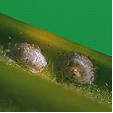
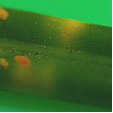 Flat Brown Scale
Flat Brown Scale
Flat Brown Scale (Eucalymnatus tessellates) are light brown up to 0.5mm long, flat and closely attached both sides of the leaf and causing yellowing of the foliage.
Juniper Scale (Diaspis carueli) is tiny and circular, white maturing to grey-black and as it feeds the needles turn yellow and die.
Oleander Scale (Aspidiotus hederae) is a pale yellow circular scale up to 3mm across and is found in dense colonies on the stem or leaves.
Tea-tree Scale (Eriococcus orariensis) are a creamy blue colour normally packed along the branches and are plump and rounded to 4mm across.

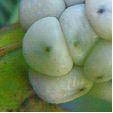 Wattle Tick Scale
Wattle Tick Scale
Tick or Wattle Scale (Cryptes baccatus) adult is domed, blue-slate colour with a leathery covering up to 10mm long. All stages of growth are found in groups of over forty, packed along the stems and normally tended by ants as they produce large amounts of honeydew. A serious pest of Acacia species found inland or coastal from temperate to sub tropical climates and commonly accompanied by Sooty Mould.
Toxic Scale (Hemiberlesia lataniae) is a tiny flat rounded scale up to 0.15mm long and is white to pale pink. It is normally found in colonies on the small branches and twigs of shrubs. It injects a toxic substance into the host as it sucks sap causing the death of the branch.
Wattle Scale (Pseudococcus albizziae) is soft, plump and secrets cotton-like threads. It is not a true scale insect and is simular to mealy bugs. It is reddish-brown up to 0.4mm long and secrets large amounts of honeydew as it sucks sap in colonies along the branches.
Life Cycle
These insects have a Hemimetabolous life cycle, ie. When the immature nymphs resemble the adults.
Appearance of the Pest
All parts of the plant above the soil may be attacked, but normally the stems and leaves and scale tends to favour well-lit positions.
Period of Activity
The nymphs and females are active for most of the year, in warm climates. Once they selected a position they attach and don't move. Normally the winged or wingless males are mobile and only soft scales produce honeydew.
Susceptible Plants
There is a wide range of susceptible plants including citrus, willows, holly, and many ornamentals, such as roses or Paeonia species. It also attacks indoor or glasshouse plants and Australian native plants such as wattles, hakeas, grevilleas and eucalyptus.
Acacia species are attacked by the Tick or Wattle Scale, which infest twigs and small branches and heavy infestations will kill the host plant.
Acer species are attacked by the Cotton Maple Scale (Pulvinaria innumerabilia) which prefers Acer saccharinum. Nymphs first attack the leaves and the brown adult scale is covered in a woolly mass up to 14mm across, normally found on the underside of the stems and twigs.
Acmena smithii, Melaleuca, Syzygium and Pittosporum species are attacked by the Chinese Wax Scale.
Aesculus species are attacked by several scale insects including the Walnut Scale (Aspidiotus juglans-regiae) which is saucer-shaped and attacks the main trunks.
Agave species are susceptible to several types of scale including (Aspidiotus nerii), (Aonidiella aurantii) and (Pinnaspis strachani), but generally do not require control.
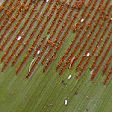 Asplenium australasicum
Asplenium australasicum
Asplenium australasicum is susceptible to Coconut Scale or Fern Scale (Pinnaspis aspidistrae). It is normally found on the under side of the fronds. Small infestations cause little damage.
Bougainvillea species may be attacked by the soft scale (Coccus hesperidum) outdoors or under glass.
Calluna and Vaccinium species are attacked by the Oyster Shell Scale (Lepidosaphes ulmi).
Camellia species may be attacked by the Florida Red Scale (Chrysomphalus aonidum), which is small, circular and black and is found firmly attached to the underside of the leaf along the veins. On inspection after removing the scale the insect has a pale yellow body. Camellias are also attacked by a large variety of scale insects including Tea Scale and Camellia Scale.
Carpinus species may be attacked by the scale (Phenacoccus acericola). It is found on the underside of the leaves forming a white cotton-like clump along the veins.
Casuarina and Allocasuarina species may be attacked by the Casuarina Scale (Frenchia casuarinae), a black hard scale that is upright to 4mm with a pinkish body. During attachment the surrounding tissue swells up and in time can, form galls. This weakens the wood and in severe infestations may kill the tree.
Cotoneaster species are attacked by up to four species of scale including the Oyster Shell Scale (Lepidosaphes ulmi).
Cupressus species are attacked by Bark Scale (Ehrhornia cupressi) is pink and covered in white wax. Heavy infestations cause the leaves to turn yellow or reddish.
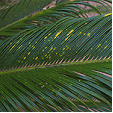 Flat Brown Scale on Cycas revoluta
Flat Brown Scale on Cycas revoluta
Cycads, palms and some species of Callistemon are attacked by the Flat Brown Scale.
Erica species are attacked by several species of scale including, Greedy, Oleander and Oystershell scale.
Jasminum species can be infested with up to twelve types of scale.
Juniperus x media and other conifer species are attacked by the Juniper Scale.
Leptospermum species are attacked by the Tea-tree Scale which produces ample honey dew that promotes sooty mould.
Palm and Fern species are susceptible to attack by the Coconut Scale or Fern Scale (Pinnaspis aspidistrae) which infests the underside of the leaves. They are also hosts for many other scale species such as red, cottony cushion and tea scale.
Pinus species are attacked by several species of scale including the Pine Tortoise Scale (Toumeyella numismaticum) and the Red Pine Scale (Matsucoccus resinosae).
Polygonum odoratum is attacked by a small brown scale.

Sorbus aucuparia is attacked by a five species of scale insect, including Black Cottony Maple, San Jose and Scurfy. Generally they suck on the sap of the new growth and leaves.
Strelitzia species are attacked by the Greedy Scale (Aspidiotus camelliae).
Damage Caused
Leaves become yellow and are shed prematurely and there may be twig or stem die-back. When the infestation occurs on fruit, the fruit is small and its skin becomes pitted and cracked. Small trees and saplings that are heavily infested may be seriously damaged or die. Sooty mould can cover fruit or leaves causing a secondary problem.
Cactus Scale can completely cover the host cactus sucking sap and causing it to die.
Cultural Control
Dead or damaged parts of the plant should be removed and destroyed including fallen fruit. Small infestations may be removed by hand or squashed on the stems. Healthy plants are less susceptible to attack, so maintain vigour of the plant and avoid using high-nitrogen fertiliser that produces excessive soft young growth.
When pruning susceptible plants paint the cuts with antifungal sealant paint as scale insects are attracted to the sweet smell of the sap. This will reduce the infection rate of the plant.
Biological Control
Natural predators such as parasitic wasps may reduce numbers of active nymphs; parasitic wasps are bred commercially in some areas for this purpose. It should be noted, however, that wasps would avoid dusty conditions.
Other predators that assist in control are assassin bugs, ladybirds, lacewings, hover flies and scale eating caterpillars. A variety of birds also attack scales.
The control of ants that transport aphid from one host to another also reduces infestation and can be carried out by applying at least three greased bandages 5mm apart around the stem or trunk of the plant.
Chemical Control
Spray the entire plant with dilute white oil solution; a follow-up spray may be required after four weeks, for heavy infestations. Spraying of chemicals will also kill of natural predators and in some cases the secondary scale infestation is more prolific especially when using copper based chemicals.
Some chemical controls, such as methidathion, are available - please seek advice from your local nursery as to the suitable product for your area.
Note
Always read the label for registration details and direction of use prior to application of any chemicals.
PEST
NAME
Fuller's Rose Weevil
Various Rose Weevil
Species
ORDER
Coleoptera
Description of the Pest
The Fuller's Rose Weevil (Asynychus cervinus) is greyish-brown and grows to 7mm long and is found in Australia. The female adult has faint white marks on its sides and feeds on leaf margins and flower buds. It lays its eggs under loose bark or in curled dead leaves that have fallen to the ground. The light grey lava is up to 6mm long burrow down feeding on the roots, where they overwinter.
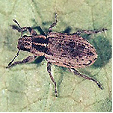
The Fuller's Rose Weevil (Pantomorus godmani) female adult is greyish-brown, up to 8mm long with diagonal white stripes across its wing covers and feeds on leaves at night. It is found in northern and southern USA. The lava feed on the roots and overwinters under ground.
Distribution of the Pest
Fuller's Rose Weevil's are found throughout the world and are distributed by walking to a new host or are transported on infested plants.
Life Cycle
These insects have a Holometabolous life cycle, ie. When metamorphosis is observed during the pupal stage.
The adult female can live up to three months during which it can lay up to ten groups of thirty eggs and the lava, can remain under ground for up to nine months before emerging as adults.
Period of Activity
The adult is most active from summer to autumn.
Damage Caused
Generally the adults chew leaves, preferring new foliage or flower buds and on mass can cause sever damage to the host. The roots are attacked by the lava and may cause yellowing of the foliage and small plants such as Lycopersicon species may be killed.
Susceptible Plants
There are many plants that are attacked by these pests, particularly broad leafed types.
Camellia, Citrus, Dahlia, Gardenia, Passiflora, Prunus, Rosa and Rubus species are susceptible to the Fuller's Rose Weevil (Asynychus cervinus).
Acacia, Begonia, Camellia, Canna, Chrysanthemum, Cissus, Citrus, Dianthus, Diospyros, Dracaena, Fuchsia, Gardenia, Hibiscus, Lilium, Pelargonium, Penstimon, Plumbago, Prunus persica, Quercus, Rhododendron, Rosa and Vinca, species.
All are susceptible to attack by the Fuller's Rose Weevil (Pantomorus godmani).
Cultural Control
Small infestations may be removed by hand at the adult stage and fallen leaves or debris should be removed from around the base of the plant. Sticky traps at the base of the plant may inhibit the adult climbing the plant.
Chemical Control
Plants may be sprayed with Carbaryl when the adults are first seen.
Note
Always read the label for registration details and direction of use prior to application of any chemicals.
Note: Plants affected by this pest are Deer Resistant plants not the susceptible plants.
PEST
NAME
Deer
Cervus species
ORDER
Artiodactyla
FAMILY
Cervidae

Description of the Pest
There are two species of the deer in North America, the Whitetail (Odocoileus virginianus) and the Mule deer (Odocoileus hemionus) with several regional variations such as the Pacific coastal Blacktail (O.h. columbianus) which is regarded as a sub-species of the Mule deer.
The Whitetail on average grows to 112 cm (44in) tall and 180 mm (70 in) long and weigh 68 kgs (150lbs). The fir colour varies according to its environment but generally it is reddish-brown during summer and grey-brown in winter with a pure white underside on its tail. When the tail is erect it is known as the "white flag". Its antlers consist of two main beams from which the points emerge.
The Mule deer grow to 105 cm (42 in) tall and are up to 200 cm (80 in) long with the adult buck weighing up to 137 kgs (300 lbs) and the does up to 80 kgs (175 lbs). The fir is generally tawny brown during summer and during winter it has a heaver grey-brown to blue-grey coat with a small white tail that is tipped in black. The other distinguishing features are its ears that are up to 300 mm (1 ft) long (mule-like) and its antlers, with the two beams that are forked into smaller beams, which inturn fork again and again.
The Blacktail deer (Pacific coastal Blacktail) grows to 97 cm (38 in) tall and is up to 105 cm (60 in) long and weighs on average 73 kgs (160 lbs). The fir is generally tawny brown during summer and during winter it has a heaver grey-brown to blue-grey coat with a tail that is dark brown at the base then changing to black for 50% of its length. The antlers consist of two beams that are forked into smaller beams, which inturn fork again and again.
Appearance and Distribution of the Pest
The Whitetail deer are found throughout eastern United States, on the coast and inland but are not commonly seen in California, Utah or Nevada. They do not migrate but congregate together (yard up) during winter and feed in a part of their existing territory.
The Mule Deer are found in the western part of North America from South eastern Alaska to Mexico and from the Pacific coast to Texas. They migrate from highland mountain meadows to southern or lower snow free forested valleys during winter.
The Blacktail deer are found on the Pacific coast from Alaska to northern California. There is both resident and migratory Blacktails. The migratory Blacktails move southwards during late autumn at the first sigh of snow or heavy sustained rain and the resident Blacktails seek cover their existing territory amongst woodlands during the winter months.
Life Cycle
All Deer breed from autumn to early winter and the does give birth from late spring to early summer.
Period of Activity
Deer are most active from spring to autumn but can be troublesome during winter when the feed is scarce. In some regions urban landscapes become the major food source both in summer and winter.
Damage Caused
Browsing deer will feed on almost any plant and is most commonly noticeable during spring feeding on the new growth or twigs and stems leaving a shredded appearance. Deer also rub their antlers against trees damaging bark and snapping off small branches, this action also incurs damage under hoof as plants, lawns and garden structures are trampled on.
Susceptible Plants
Some plants are more palatable to deer but when a deer is hungry or during drought conditions there are no "Deer Proof" plants. There is a range of plants that have a bad taste and are not destroyed and are regarded as (deer resistant plants). Deer resistant plants are the plants that are attached to this file not the susceptible plants.
Cultural Control
There are many cultural controls that have been tried to move browsing deer such as frightening them with strobe lights, pyrotechnics or tethered savage dogs. These actions are only temporary and may cause more trouble as the stampeding animals move off. Fencing and netting can be an effective method of discouraging hungry deer from gardens but may be expensive on a large scale and require maintenance. There are several types of fences which include conventional 2.2m (8 ft) deer-proof woven wire fences or single-wire electric fences and slanted deer fences. Plant selection can also be effective, by using less desirable plants (deer resistant plants) as an outer border to the more desirable plant species and thus discouraging the deer to enter the garden. Hedges and windrows of less desirable thorny plants can also be a deterrent to browsing deer.
Chemical Control
There are two main types of repellents contact and area. Contact repellents are applied directly to the plants and deter deer with a bad taste or smell. They can be applied by rubbing or spraying on to the plants and commonly used in an egg mixture. The commercial products have proven to work better than home remedies which include soap or chilli mixtures and hanging bags of human hair.
Area repellents rely on an offensive odour and are placed around areas that are frequently visited.
Contact your local distributor for available types and application.
Note: Plants affected by this pest are the Rabbit Resistant plants not the susceptible plants.
PEST
NAME
Rabbits
Oryctolagus cuniculus & Sylvilagus species
ORDER
Lagomorpha
FAMILY
Leporidae

Description of the Pest
There are a eight different genera in the family classified as rabbits and include the European Rabbit (Oryctolagus cuniculus) which has infested Australia and the Cottontail rabbit (Sylvilagus spp.) which consists of 13-species with 9-species found in North America.
Generally rabbits have an egg-shaped body that can range in size from 200 mm to 500 mm long and weigh up to 2 kg. They have long ears that are adapted for detecting predators and powerful large hind legs allowing them to move fast. The body is covered in buffed, long soft fur that is brown or grey and the mouth has two sets of incisor teeth which are located one behind the other.
The cottontail rabbit grows up to 450 mm (18 in) tall and weighs 1.36 kg (3 lbs).
Appearance and Distribution of the Pest
Generally rabbits live in a variety of habitats including meadows, woodlands, forests, grasslands or deserts and wetlands living in groups with some underground in borrowers. The European Rabbit has been introduced to many parts of the world and in 1859 Thomas Austin brought 24 breeding pairs to Australia which subsequently escaped and quickly bred throughout Victoria and New South Wales and by the 1900's the rabbits had reached the Northern Territory and Western Australia.
Life Cycle
The life span varies with each species. Cottontails for example can live for one year to a maximum of three years in the wild but in captivity they can last for eight years, during which time they can raise between 2-6 litters per year and produce up to 18 kittens during the breeding season. In the cooler northern parts of North America the size and number of litters are generally smaller only 2-3 but in southern regions such as Mexico or Australia, European rabbits can produce 5-6 litters per year, normally commencing during spring time and continuing throughout the year. Each litter can consist of 2-8 or more kittens. Under ideal seasonal conditions a mature doe (female) can mate again several hours after giving birth and has a gestation period from 28-30 days.
Period of Activity
Generally rabbits eat throughout the year but in cooler countries such as North America they are more active during the spring to summer period but in warmer climates such as Australia rabbits can cause significant damage throughout the year.
Damage Caused
in Australia the effects of rabbits on the landscape has been a devastating resulting in the loss of an unknown number of plant species and a ring barking of young trees in orchards or forests. Major erosion problems have also resulted from warrens or plant denuded landscapes which are left vulnerable to the elements.
A rabbits generally will eat most flowers or the bark of woody plants, grasses of all types and most agricultural crops (vegetables).
Susceptible Plants
Rabbits mainly consumed grasses or garden vegetables and a broad range of ornamental plants. In cool climates where snowfalls rabbits eat twigs, bark and buds from the dormant plants. When rabbits are hungry they will eat most plants but attached to this file are rabbit resistant plants that are less palatable. Their resistance will vary depending on the stage of growth as new shoots are very desirable to rabbits.
Cultural Control
Control methods include trapping, hunting and exclusion with the use of fences, all of which had a marginal success. Many predators utilise rabbits as a food source for example foxes, feral dogs and cats, hawks or owls and human hunters.
Biological Control
In Australia to biological diseases have had reasonable success. In 1950 Myxomatosis was released into the rabbit population and resulted in the numbers dropping from 600 million to 100 million. Remaining populations became immune and steadily increased numbers to 300 million by the 1990s. The calicivirus was accidentally released in 1996 and culled populations significantly in regions of extreme heat but was less effective in cooler regions where the rabbits were exposed to a lesser calicivirus that immune them.
Chemical Control
Baiting and chemical repellents programs relied on the territorial habits of rabbits as they rarely forage further afield from their territorial areas.
Note
Landholders should seek advice from their local government agencies. This advice will include fumigation or destruction of warrens, fencing and shooting.
DISEASE
NAME
Canker (General)
Various Canker Species
Description
This is a fungal problem that enters the plant through wounds causing dieback of twigs and stems.
Symptoms
The stems become discoloured (pale brown) usually from a pruned point, working its way down the stem and normally intersecting or surrounded with live cambium. The bark splits or cracks, foliage dies and infected areas can develop tiny black fruiting bodies. Heavy infected plants eventually die, though certain varieties are resistant halting the spread of the infection.

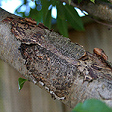
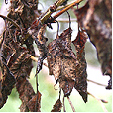
Black Canker (Phyaslospora miyabeana) forms dark brown spots with concentric rings on the upper leaf surface and grey spots on the stems. The tiny black fruiting bodies develop in the stem lesions. It is found on Salix species and persistent attacks will kill the tree.
The Canker (Cytospora valsa) causes the browning and death of branches in Picea abies and Picea pungens. This infection occurs normally from the base of the tree with infected needles falling, and white resinous patches appearing on the bark accompanied by cankers with tiny black fruiting bodies.
The Canker (Corynneum cardinale) is a casual fungus that invades wounds and infects living bark and associated cambium turning the foliage yellowish. As it spreads it girdles the branch killing it and ultimately the top of the tree dies out. Cankers eventually form in the trunk and ooze resin. It is found on Cypress.
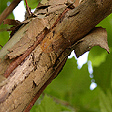 Platanus x hybrida
Platanus x hybrida
Cankerstain (Ceratocystis fimbriata f. platani) forms sunken cankers on the trunk and large limbs forming longitudinal cracks and roughened bark. Infected areas form callus around the margins which dies off and when cut open, dark coloured streaks are revealed extending to the central pith. These streaks then radiate out into uninfected wood resulting in the thinning of the crown and producing unusual small leaves. It is normally transmitted through poor tree surgery techniques and infected tools.
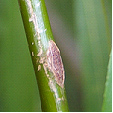 Cytospora Canker
Cytospora Canker
Cytospora Canker (Cytospora chrysosperma) is a casual fungus that infects the young twigs, then moving to the stems, branches and trunk causing brown sunken areas to appear that is covered in red pustules. The fungus tends to attack trees that are in poor health. Control requires the removal of infected branches and improved culture to regain the plants vigour. Sorbus aucuparia, Salix and Popular species are susceptible.
 Cypress Canker
Cypress Canker
Cypress Canker (Seiridium species) enters the plant through wounds or through insect damage causes the bark to spread revealing brown powdery spores that are accompanied by oozing resin. The canker eventually girdles the branch or trunk causing ringbarking and the death of the plant.
Nectria Canker (Nectria Cinnabarina) forms cankers on the twigs and small branches producing red fruiting bodies and eventually killing the tree. It is found in many parts of the world infecting a range of trees including hardwoods.
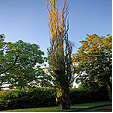
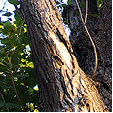
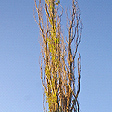 Populus nigra
Populus nigra
Poplar Canker (Cryptodiaporthe populea) infects the cambium layer damaging the bark and sapwood where the elongated sunken canker forms. Branches are girdled causing the upper portion to die off. This is a serious problem for Populus nigra var. Italica entering the plant through wounds or the leaves then spreading to twigs and branches. Control is difficult as removal of infected parts will not eradicate the problem, but encourage it. Young plants may be sprayed with a copper based fungicide to reduce leaf infection and heavily infected plants should be removed the burnt.
Stem Canker of Red Flowering Gum (Sporotrichum destructor) enters through wounds in the bark forming cankers in the trunk and branches, splitting the bark apart, revealing the wood and infesting the surface with powdery spores. This infection causes the leaves to wither and then the branches die, eventually killing the tree.
Stem Canker (Strumella coryneoidea) is a casual fungus that forms on the trunks of trees as a smooth, dispersed or sunken infection. On mature trees the infection sheds the bark with the canker forming callus tissue around the margins and the centre being exposed. These cankers then tend to extend up and down the trunk, only girdling over a long period of time. It is found on Quercus, Fagus, Aesculus species, and Acer rubrum , Nyssa sylvatica, Carya ovata and Morinda citrifolia.
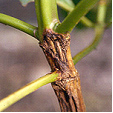
Source and Dispersal
The spores are found on infected dead plant material and can be dispersed by wind and with splashing water.
Favoured Conditions
It prefers a warm humid conditions and plants that have a wounds derived from poor pruning techniques and insect or other damage, especially if water is allowed to settle on the wound.
Affected Plants
Cankers may infect a wide range of trees and shrubs with some species being specific to its host. Examples are listed below.
Abies species are infected by several cankers including (Cytospora pinastri), (Cryptosporium macrospermum) and (Scoleconectria balsamea). These fungi form dead sunken areas on the trunk and branches.
Alnus species are infected by a few cankers including (Nectria coccinea) and (Physalospora obtusa) these attack the branches causing die back.
Betula species may be infected by the Canker (Nectria galligena) that occurs in the forks of trees causing splitting and cracking of the bark by swelling, to reveal the canker. Callus rings may form around the affected areas as a defence mechanism triggered by the tree.
Buxus species are infected by the Canker (Pseudonectria rousseliana) which shows signs of poor new growth during spring with the leaves turning from light green to a tan colour. These leaves tend to lay flat along the stems and reddish pustules appear both on the stems and leaves. The bark becomes loose and on inspection reveals a darkish colour underneath. It is difficult to control and the canker can kill the plant.
Castanea species are infected by the Twig Canker (Cryptodiaporthe castanea), a fungal problem that causes significant damage to the twigs and small branches, but tends to attack stressed trees.
Cercis and Ribes species are infected by the Canker (Botryosphaeria ribis) which forms small sunken areas on the stems causing wilting and eventually killing the branch by girdling. The cankers turn the bark black then split it open and the adjoining wood becomes discoloured. This is a serious problem for this and many other plant species.
Cotoneaster, Betula, Catalpa and Aesculus species are infected by the canker (Physalospora obtusa).
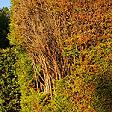
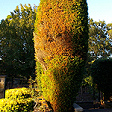 Cypress Canker
Cypress Canker
Cupressus species and Chamaecyparis lawsoniana are susceptible to Cypress Canker (Seiridium species) which causes leaf browning and then girdles the trunks resulting in ringbark. There is also another Canker (Coryneum cardinale) that has simular characteristics and is found in the northern hemisphere.
Cupressus sempervirens is infected by Cytospora Canker (Cytospora cenisia var. littoralis).
Larix species are susceptible to several fungal cankers including (Trichoscyphella wilkommii), (Trichoscyphella ellisiana), (Aleurodiscus amorphus), (Leucostoma Kunzei) and (Phomopsis spp.)
Nyssa sylvatica is attacked by three cankers including (Strumella coryneoidea).
Pinus species are infected by many types of cankers.
Platanus species are infected by Cankerstain.
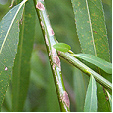 Cytospora Canker on Salix babylonica
Cytospora Canker on Salix babylonica
Pseudotsuga menziesii Douglas Fir is attacked by several cankers including (Cytospora species), (Dasyscypha ellisiana), (Dasyscypha pseudotsugae), (Phacidiopycnis pseudotsugae) and (Phomopsis lokoyae). These infections normally do not require control and are more prevalent on the coastal form.
Salix and Populus species are infected by several cankers including Cytospora Canker (Cytospora chrysosperma), Hypoxylon Canker (Hypoxylon pruinatum), Septoria Canker (Mycosphaerella populorum) and Branch Gall (Macrophoma tumefaciens). Many of these fungi can cause the death of the plant.
Thuja orientalis, Cupressus and Juniperus species are infected by the canker (Corynneum cardinale).
Tilia and Acer species are infected by (Nectria cinnabarina) attacking twigs or branches.
Tsuga species are infected by several cankers including (Dermatea balsamea) and ( Cytospora species).
Ulmus species are infected with up to eight fungal cankers including (Apioporthe apiospora) and (Nectria coccinea).
Vaccinium ovatum is infected by the canker (Coryneum microstictum) which attacks the stems.
Vinca species are infected by canker-dieback (Phomopsis livella) causing the shoots to wilt, turn brown and die. This can reduce the plant to ground level, and normally occurs during rainy periods.
Non-chemical Control
It is very difficult to control and correct pruning techniques with sharp tools for repairing wounds or prune well below the infected areas. Ensure that there are no ragged edges on the cuts and the angle should cut allows water to run off or dress the wound. Plant resistant varieties when available. Heavily infected trees should be removed to avoid spreading the disease.
Improve the culture of the affected plant to increase vigour for greater resistance.
Chemical Control
There is no satisfactory chemical control and prevention is imperative.
Note
Always read the label for registration details and direction of use prior to application of any chemicals.
DISEASE
NAME
Grey Mould
Botrytis cinerea, B. elliptica
Description
Grey Mold, Shoot Blight, Petal Blight is a fungus problem that generally forms water-soaked spots that rot and produces greyish sclerotia (fungal resting bodies) on the surface. They can be found throughout the year on dead tissue and on live material during under ideal climatic conditions. Damaged areas such as a tear in a leaf or an opening made by an insect are more likely to be infected.
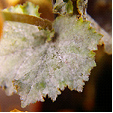 Grey Mold on Begonia species
Grey Mold on Begonia species
Image by B. Sonsie
Symptoms
The fungus attacks stems, leaves, flowers and fruit. In roses the fungus is primarily attacks the flowers producing pink rings on the petals and buds that become brown and rotten. This may extend down the peduncle to the stems causing dieback.
In other plants oval yellowish to brown spots appear, then the centre turns greyish and dries out and in humid weather the spots spread, joining up and infecting the entire leaf. This infection may also occur on the stems, and flowers may form abnormally or brown off and die.
When lettuce is infected it starts at the base causing a soft brown rot that may extend up the stem killing the plant, and pears flowers become infected then spreading to the fruit. This develops a sunken brown area that is soft and eventually is covered in grey powdery spores.
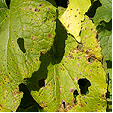
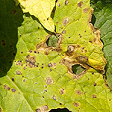 Botrytis Blight on Senecio cruentus
Botrytis Blight on Senecio cruentus
Botrytis Blight (Botrytis tulipae) infects leaves, flowers and stems with flecks of brown spots that merge to form light grey rotted areas that have brownish margin that may destroy stems. Affected areas are covered in a grey mould during humid conditions. The spores overwinter in dark brown sclerotia, which are found on the outer scales of the bulb or at the base of the stem in Tulipa species.
Grey Bulb Rot (Rhizoctonia tuliparum), which infects the bulbs of Tulipa species, attacking the base of the leaves and rotting the bulb. When bulbs emerge during spring in infected soil's they soon die off. The greyish mold tends to be dry.
Source and Dispersal
The sclerotia (fungal resting bodies) are found on dead plant material or in the soil and remain viable for many years. The spores are dispersed by wind or splashing water.
Favoured Conditions
It prefers cool moist climate with morning dew.
Affected Plants
Grey Mold attacks a wide range of plants including roses, fruit trees, pelargonium, ferns, grapes and cyclamens. Heliotropium , Amaryllis, Lilium and Hippeastrum species are also infected.
Agave species are infected by two fungal Leaf Blights (Botrytis cinerea) and (Stagonospora gigantea) that severely damage the leaves particular during wet periods or from excessive watering.
Cactus species are infected by soft rot or Grey Mould (Botrytis cinerea). Stems and pads turn are greyish with the upper surface, rotting then collapsing. The dieing tissue becomes slimy and is covered with grey mould that develops black sclerotia, which propagates the disease. It is more prevalent under warm humid conditions and control methods include removing infected parts and destroying them. In glasshouse situations ventilation should be improved and watering should be restricted to create a drier atmosphere.
Cereus species and other cacti are infected by Grey Mold causing the segments to become discoloured and as the rot progresses it tissue becomes slimy and collapses. Black sclerotia forms on the affected areas that are covered in grey mold during humid conditions.
Cuphea species are infected by this blight.
Orchids such as Cattleya, Cymbidium, Cypripedium, Dendrobium, Epidendrum, Oncidium, Paphiopedilum, Phalaenopsis and Zygopetalum species are infected by Grey Mold or Petal Spot (Botrytis cinerea). Petal and flower stalks form small brown spots.
Paeonia species are infected by Botrytis Blight (Botrytis paeoniae) causing the leaves and flowers to form a grey mold then suddenly collapse and die.
Pseudotsuga menziesii Douglas Fir is infected by Leaf and Twig Blight (Botrytis cinerea). This is a serious problem in wet conditions and is difficult to control.
Ribes species are attacked by Cain Blight (Botryosphaeria dothidea). The infection causes the cains to become blighted and wilt. To control remove damaged wood and destroy.
Non-chemical Control
Remove and destroy infected plants or fallen leaves. When planting, space as to allow good air movement to reduce humidity. Bulbs that are infected should be discarded and take care that bulb scales are removed from the soil to prevent further infection. Cactus and succulents that are infected should have the damaged areas cut out, or discard the entire plant. Under glasshouse conditions improve the ventilation and reduce watering to create a drier atmosphere.
Chemical Control
Under humid conditions spray regularly using a suitable fungicide such as thiram, mancozeb, dichloran and chlorothalonil.
Note
Always read the label for registration details and direction of use prior to application of any chemicals.
DISEASE
NAME
Leaf Spot (General)
Various Leaf Spot Species
Description
There is a wide variety of fungal leaf spots that infect perennials, shrub and trees. Some are specific to the host while others can affect a range of plants.
Symptoms
Generally light brown to purplish or blackish spots appear on the leaf and form concentric rings of fruiting bodies. The spots may leave holes, perforating the leaf or expand with pale green to yellowish margins and when the holes merge the leaf normally dies. There are many different types of leaf spot, some are discussed below.
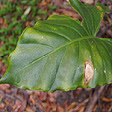 Alocasia species
Alocasia species 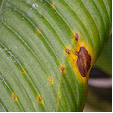
Alternaria Leaf Spot (Alternaria nelumbii) forms a small reddish brown spots that are boarded in light green, and as they develop in size the leaf curls and dies from the margin inwards. Normally occurs on Nelumbo species (water lilies).
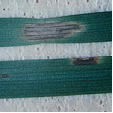 Helminthosporium Disease
Helminthosporium Disease
Helminthosporium Disease (Bipolris species), (Drechslera species) and (Exserophilum species) are responsible for several leaf spots that occur on all Turf Grass species. Generally they form black or white spots that may be faded and produce masses of spores in the thatch during late summer, under humid conditions. The life cycle is short and when conditions are favourable spores are splashed onto the foliage from the thatch, causing wide spread infection. Cynodon dactylon (common couch) is most susceptible and found in bowling or golf greens where it is a serious problem.
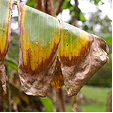 Banana Leaf Spot
Banana Leaf Spot 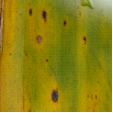
Banana Leaf Spot (Mycosphaerella musicola) is found on many species of banana causing pale yellow streaks on the young leaves to turn brown with dark spots. The leaf then becomes dried, brown and dead commencing from the margins, eventually the leaf dies. Control requires removal of infected foliage or the spraying of a fungicide and fungicides should not be used during the fruiting period.
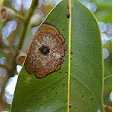
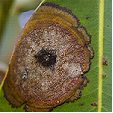 Lophostemon confertus (Brush Box)
Lophostemon confertus (Brush Box)
Leaf Spot on Brush Box (Elsinoe species). This is a casual fungus that attacks the epidermal layer of the leaf, forming circular spots that are up to 25mm across and are often restricted by the main vein. These spots are a dull yellowish brown but can also have purplish patterns. A leaf may have more than one spot develop on its surface and normally appears on scattered leaves throughout the tree. This doesn't affect the vigour of Lophostemon confertus.
Palm Leaf-scab (Graphiola phoeicis) appears as yellow spots and develop into scabs or warts that are outwards hard and dark but with a soft centre with powdery yellowish brown spores. The infected leaves eventually die.
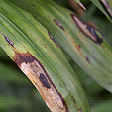 Palm Leaf Spot, Chamaedorea elegans
Palm Leaf Spot, Chamaedorea elegans
Palm Leaf Spot (Pestaloptiopsis species) appears as a small spot with a dark centre on the leaves and affects palms that are growing in shaded humid positions and normally control is not required, though infected fronds should be removed.
Source and Dispersal
Infection source is other contaminated plants and the spores are spread by wind or by splashing water. The fruiting bodies are black spots that appear on the damaged tissue releasing spores.
Favoured Conditions
This fungus prefers a warm humid environment and leafy plants with soft new growth, particularly if they are crowded.
Affected Plants
There are many ornamental and native plants that are hosts to a wide range of fungal leaf spots. Some specific ones are listed below. Plants such as Cornus or Paeonia species are infected by a large variety of leaf spots, while other plants attract a specific leaf spot.
Generally a healthy plant can tolerate fungal leaf spot attack, though it may make the plant look unsightly. In trees and shrubs it is difficult to control and generally not necessary, but in perennials and annuals control may be necessary in order to save the plant.
Acalypha and Arctotis species are infected by up to three leaf spots including (Cercospora acalyphae) and (Ramularia acalyphae) that rarely require control.
Acer species are infected by Purple Eye (Phyllosticta minima) which forms spots with brownish centres and purplish margins causing the death of the leaves.
Acer species are also infected by Tar Spot (Rhytisma acerinum) which forms round black spots that have yellow margins. Not normally seen on cultivated trees, but seen in forests.
Adiantum, Asplenium, Blechnum, Cyathea, Davallia, Nephrolepis, Platycerium, Polypodium and Pteris species are infected by the leaf spot (Pseudocercopora species) which forms circular brown spots on the fronds and heavy infection can defoliate a plant.
Aesculus species are occasionally infected with the leaf spot (Septoria hippocastani) which forms small brown spots.
Agave species are susceptible to the leaf spot (Coniothyrium concentricum), which appear as greyish spots up to 20mm (1in) across with concentric rings and black fruiting bodies. Affected leaves are destroyed as the infection spreads.
Albizia julibrissin is susceptible to the fungal leaf spot (gloeosporium aletridis), which does not normally require control.
Amelanchler, Chaenomeles, Crataegus and Rhaphiolepis species Mespilus germanica are infected by the leaf spot (Fabraea maculata) which may cause considerable damage during wet periods.
Aquilegia species can be infected by three types of Leaf Spot including (Ascochyta aquilegiae), (Cercospora aquilegiae) and (Septoria aquilegiae), normally appearing during humid conditions forming spots on the leaves.
Arbutus species are infected by two leaf spots (Septoria Unedonis) which produces small brown spots on the leaves and (Elsinoe mattirolianum).
Arctostaphylos manzanita is infected by the leave spot (Cryptostictis arbuti) which damages leaves but is not normally detrimental to the shrub.
Aspidistra species are infected by the leaf spot (Colletotrichum omnivorum) causing whitish spots on the leaves and petiole.
Aster species are infected by many leaf spots including (Alternaria species), (Cercosporella cana), ( Ovularia asteris) and (Septoria asteris).
Aucuba species are infected by several leaf spots, usually as a secondary infection after aphid attack. These include (Phyllosticta aucubae) and (Phyllostica aucubae).
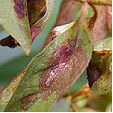
 Azalea
Azalea
Azalea (Rhododendron species) are susceptible to Leaf Scorch (Septoria azalea). This fungal disease forms reddish- brown spots which expand and engulf the leaf, with fruiting bodies appearing in the centre. Infected leaves die, then fall and the branchlets wilt. This problem is more serious during wet periods and may require control using a fungicide.
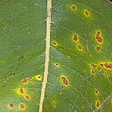 Banksia robur
Banksia robur
Banksia species are infected by several leaf spots causing chlorotic areas that have brown centres and is not normally a major problem for the plant.
Betula species may be infected by the Leaf Spots (Gloeosporium betularum) that forms brown spots with darker margins and (Cylindrosporium betulae) that also forms brown spots with faded indefinite margins.
Bougainvillea species are infected by the leaf spot (Cercosporidium bougainvilleae) which forms rounded spots with dark margins that yellowish ting. Infected leaves die and fall from the plant.
Calendula species are infected by the Leaf Spot (Cercospora calendulae) which rapidly infects the plant spotting the leaves and killing the plant.
Callicarpa species may be infected by the leaf spot (Atractilina callicarpae) forming irregular brownish spot or (Cercospora callicarpae) which can defoliate the plant in subtropical climates.
Campsis species may be infected by several fungal leaf spots including (Phyllosticta tecomae), (Septoria tecomae) and (Cercospora duplicata).
Carpinus species are infected by the leaf spots (Gloeosporium robergei), (Gnomoniella fimbriata) and (Septoria carpinea), all are minor infections not normally requiring control.
Carya species are infected by several leaf spots including (Gnomonia caryae) that infects leaves with irregular reddish spots on the upper surface with corresponding brown spore producing spots on the underside. It also has a secondary spore release that occurs on the dead leaves where it over winters. Other leaf spots include (monochaetia desmazierii) and (Marssonina juglandis).
Ceanothus species are susceptible to the leaf spot (Cercospora ceanothi) and (Phyllosticta ceanothi) both are of minor importance not requiring control.
Celtis species are infected by many leaf spots including (Cercosporella celtidis), (Cylindrosporium celtidis), (Phleospora celtidis) and (Septogloeum celtidis).
Chrysanthemums species are infected by the leaf spot (Septoria species) which forms yellow spots appear toward the edge of the leaves; these become enlarged brownish patches with yellow margins. Damaged areas may converge and in severe attacks and the leaves may fall prematurely or flower production is reduced.
Clematis species are infected by the fungal disease (Ascochyta clematidina) which may cause stem rot or leaf spots that are water soaked areas with reddish margins. The infection spreads from the leaves to the stem causing wilting and eventually girdling the stem killing the plant. There are many fungal leaf spots that infect this plant including (Cercospora rubigo) and (Septoria clematidis)
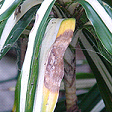 Dracaena deremensis
Dracaena deremensis
Cordyline and Dracaena species may be infected by the leaf spot (Phyllosticta maculicola) which forms small brownish spots that have yellowish margins and has black fruiting bodies that forms coils of spores. These plants are also susceptible to other leaf spots such as (Glomerella cincta) and (Phyllosticta dracaaaenae). Keep foliage dry to avoid infection.
Cynodon dactylon, Pennisetum clandestinum and many other Turf Grasses are susceptible to Helminthosporium Disease.
Daphne species are infected by the leaf spot (Gloeosporium mezerei) and (Marssonina daphnes) both of which form thickish brown spots that are seen on both sides of the leaves. Infected leaves turn yellowish before dieing.
Dendranthema species are infected by many leaf spots such as (Septoria chrysanthemi) which first forms yellowish spots up to 25mm (1in) across that become black. Infected leaves die prematurely and persist on the plant.
Dianthus species may be infected by the leaf spot (Septoria dianthi). It forms light brown rounded spots that have a purplish border. The scattered spots on the lower leaves can also be found on the stems and the spores are dispersed by water from the tiny black fruiting bodies.
Dieffenbachia species are infected by several leaf spot fungi including (Cephalosporium species) and (Myrothecium species).
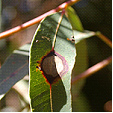 Eucalyptus species
Eucalyptus species
Eucalyptus species are infected by many fungal leaf spots such as (Mycosphaeralla species), (Hendersonia species) and (Monocheatia monochaeta). Generally leaf spots appear on the juvenile or new leaves causing brownish spots that enlarge and may have a purplish halo around the margin. Mature adult leaves are not normally infected and the trees rarely require control measures.
Fern species are infected by the leaf spot, (Alternaria polypodii). This fungus appears as brown circular or oblong spots that congregate along the margins of the pinnae causing the fronds to turn brown and die. It is spread by wind currents from plant to plant and control methods include removing infected fronds and maintaining a drier atmosphere.
Ficus species are infected by various fungal leaf spot including (Pseudocercospora species). Generally the fungal attack forms circular or irregular dark coloured spots on the leaves eventually causing them to fall prematurely.
Ficus elastica is susceptible to many fungal leaf spots including (Alternaria species), (Leptostromella elastica) and (Phyllosticta roberti).
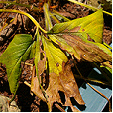
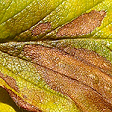 Strawberry
Strawberry
Fragaria x ananassa (Strawberry) is infected by the fungal leaf spot (Mycospharella fragariae). The mature leaf is initially infected with well defined brown spots that that turn light grey with red-purplish margins. As the spots merge they form large brown blotches and the leaf turns yellow then dies. This fungal attack normally occurs on plants in poor health and can be a serious problem early in the season seriously damaging stock.
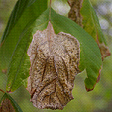 Fraxinus species
Fraxinus species
Fraxinus species are infected by the leaf spot (Gloeosporium aridum) giving the leaf a scorched appearance as large blotches appear from the margin or apex and turn brown with a papery texture. It is more prevalent during rainy periods and infected leaves fall prematurely. Collect and depose of fallen leaves otherwise control is not normally required.
Fuchsia species may be infected by the leaf spot (Septoria species) or ( Cercospora species), both form spots with dead centres and dark margins.
Gladiolus species are infected by Hard Rot or Leaf Spot (Septoria gladioli). On the corms reddish brown circular water soaked spots become large and sunken. These areas dry out and form obvious margins. The leaves may also have these symptoms but is not commonly seen.
Hemerocallis species are infected by several leaf spots including (Cercospora hemerocallis) and (Heterosporium iridis). These may be in the form of black spots or brownish spots that converge killing the leaf. Infected leaves should be removed and burnt.
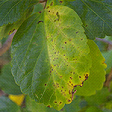 Hibiscus species
Hibiscus species
Hibiscus rosa-sinensis, Hibiscus syriacus and Hibiscus tiliaceus are susceptible to several fungal leaf spots including (Ascochyta abelmoschi), (Cerospora kellermanii) and (Phyllosticta hibiscina). All cause spotting or blotching of the leaf surface; remove and destroy infected parts.
Hydrangea species are infected by four fungal species including (Ascochyta hydrangeae), (Phyllosticta hydrangeae) and (Septoria hydrangeae).
Iris species are infected by several fungal leaf spots including (Alternaria iridicola) and (Macosphaerella species).
Iris species are also infected by the leaf spot (Didymellina macrospore) that forms greyish spots with brown water soaked borders and coalesce on the upper part of the leaf. This casual organism commonly occurs after flowering killing the leaves but will not infect the bulbs. The bulbs become weak over several seasons due to the decreased foliage.
There is also a Bacterial Leaf Spot (Bacterium tardicrescens) that is commonly mistaken as a fungal problem causing translucent spots that coalesce and involve the entire leaf. Normally found on Iris species.
Laburnum anagyroides is infected by the Leaf Spot (Phyllosticta cytisii). The leaf forms light grey spots with no definite margin and mature to brown. The black fruiting bodies appear as dots in the centre of the spot.
Leucanthemum species are infected by the leaf spot (Cerocspora chrysanthemi) and (Septoria leucanthemi).
Magnolia species are susceptible to many species including (Alternaria tenuis), (Mycosphaerella milleri) and (Phyllosticta species). Leaves generally turn brown from the apex or margins turning brown or spots appear on the leaf surface and leaves become yellow before withering and dieing. Normally the make the tree look poorly but have little effect on its growth. Control is not normally required.
Nerium oleander is susceptible to several fungal leaf spots including (Cercospora nerella), (Cercospora repens), (Gloesporium species) and (Phyllosticta nerii). Infected leaves should be removed but generally control is not required.
Nyssa sylvatica is infected by the leaf spot (Mycosphaerella nyssaecola) forming irregular purplish blotches.
Orchids such as Cattleya, Cymbidium, Cypripedium, Dendrobium, Epidendrum, Paphiopedilum, Phalaenopsis and Zygopetalum species are infected by several leaf spots including (Cerospora, Colletotrichum and Phyllosticta species). Normally forming dark or dead, circular or irregular areas on the leaves.
Palms such as Syagrus, Howea, Phoenix, Roystonea and Washingtonia species are infected by Leaf-scab (Graphiola phoeicis).
Palms such as Archontophoenix, Caryota, Chamaedorea, Cocos, Dypsis, Howea, Liculia, Linospadix, Livistona, Phoenix, Ptychosperma, Rhapis, Roystonea, Syagrus, Washingtonia and Wodyetia species are susceptible to several fungal leaf spots including;
(Bipolaris spp.), (Cylindrocladium spp.), (Colletotrichum spp.) and (Pestalotiopsis spp.).
Generally the circular leaf spots are brown and may have a yellow halo such as Palm Ring Spot (Bipolaris incurvata). They vary in size from small to large depending on the species. When a plant is healthy it recovers from attack, but heavy infections can defoliate, causing the collapse of the plant.
Palms are also infected by the Brachybasidium Leaf Spot (Brachybasidium pinangae). This fungus forms angular leaf lesions that produce fruiting bodies on the underside and is commonly found on Archontophoenix species.
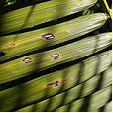
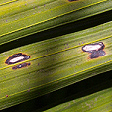 Archontophoenix cunninghamiana
Archontophoenix cunninghamiana
Passiflora species are infected with many types of leaf spot such as (Alternaria passiflorae).
Phoenix species are susceptible to False Smut (Graphiola phoenicis). This fungus forms yellow leaf spots that become hard with a raised with a blackish scab, which produces masses of powdery spores that are thread-like.
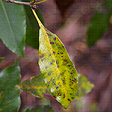
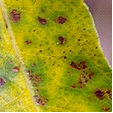 Pittosporum species
Pittosporum species
Pittosporum species are susceptible to the leaf spots (Alternaria tenuissima), (Phyllostica species) and (Cercospora pittospori). Circular or angular dark spots appear on the leaves and are surrounded by necrotic areas that are yellowish. Generally removal of infected leaves is adequate control.
Poa species and other cool season grasses are infected by Winter Fusarium Leaf Disease (Fusarium species), which causes small pale spots that are water soaked to appear on the leaves that turn red-brown. Infected leaves become bleached then wither and die, but the infection will not affect the crown or roots of the plant. It can be identified by pink, cotton-like mycelium and the plant prefers cold wet weather.
Populus species are infected by several fungal leaf spots including (Ciborinia bifrons, Ciborinia confundens), and (Mycosphaerella populicola).
Prunus species are infected by several leaf spots including (Cercospora circumscissa and Septoria ravenelii).
Pseudotsuga menziesii Douglas Fir is infected by the Leaf Cast (Rhabdocline pseudotsugae) Symptoms include the needles becoming yellowish at the apex and extending down the needle and spreading to others during moist spring weather turning them brown. Brownish scorched areas are noticeable on the tree from a distance. Control; is not normally required for mature trees but nursery stock may require spraying with a copper based fungicide.
Psidium guajava (Guava) is infected by (Glomerella cingulate). This fungus courses spots to appear on leaves and mummifies and blackens immature fruit or rots mature fruit. This fungus can devastate a guava crop.
Quercus species are infected by several types of leaf spot including (Cylindrosporium microspilum) and (Marssonina martini). These attacks tend top take place later in the season and normally not detrimental to the tree.
Rhododendron species are infected by a large variety of fungal leaf spots including (Cercospora rhododendri) and (lophodermium melaleucum)
Salix species are infected by several fungal leaf spots including (Ascochyta salicis) and (Septogloeum salicinum).
Senecio species are infected by the fungal leaf spot (Alternaria cinerariae) and (Cercospora species), forming dark rounded or angular spots.
Spiraea species are attacked by the fungal leaf spot (Cylindrosporium filipendulae).
Stenotaphrum secundatum (Buffalo) turf grass is susceptible to Grey Leaf Spot (Pyricularia grisea) in domestic and commercial situations devastating lawns. This fungal disease infects the stems and leaves with small brown lesions that enlarge rapidly forming grey-brown spots that have darker borders or surrounded by yellow chlorotic areas. This infection is commonly found on newly laid turf but will also infect established lawns. It is most prevalent during warm humid periods in soil with a high nitrogen level.
Syringa species are attacked by up to six species of leaf spot including (Cercospora lilacis) and (Phyllostica species).
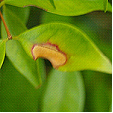 Syzygium species
Syzygium species
Syzygium species are infected by fungal leaf spots but normally control is not required.
Tagetes species are infected by the leaf spot (Septoria tageticola), which starts at the base and moves progressively up through the plant, covering the leaves in grey to black spots.
Trillium species are host to several leaf spots, including (Colletotrichum peckii) (Gloeosporium Trillii) (Heterosporium trillii).
Ulmus species are infected by many fungal leaf spots including (Gnomonia ulmea) and (Cercospora sphaeriaeformis).
Veronica species are infected by the leaf spot (Septoria veronicae). The symptoms include small violet to brown spots appear on the upper surface of the leaf and correspondingly yellowish brown on the underside. The spots converge forming a scorched shot-hole appearance and eventually death of the leaf.
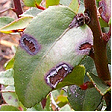 Vaccinium ovatum
Vaccinium ovatum
Vaccinium ovatum is infected by the leaf spot (Rhytisma vaccinii) and (Dothichiza caroliniana).
Vicia species are infected by the leaf spot (Erostrotheca multiformis), which forms greyish spots that enlarge and may defoliate the plant.
Wisteria species are infected by three fungal leaf spots (Phyllostica wisteriae), (Septoria wisteriae) and (Phomatospora wisteriae).
Non-chemical Control
Remove and destroy infected plant material and avoid overhead watering. When planting select infection resistant varieties. Practice crop rotation and add pot ash to the soil to decrease the plants venerability to the disease. Many species of fungus overwinter in fallen leaves, remove and destroy any litter under the plant.
Winter Fusarium Leaf Disease in Turf Grasses can be minimised by aerating the soil, reducing thatch and avoid excessive nitrogen in the soil.
Chemical Control
Protective fungicides such as zineb or copper oxychloride should be sprayed at the first sign of infection and cuttings should be sprayed as they start to grow.
Note
Always read the label for registration details and direction of use prior to application of any chemicals.
DISEASE
NAME
Fungi (General)
Various Fungal species
Description
A fungus is a plant that lacks chlorophyll and conductive tissue. Generally they are made up of branched threads called 'hyphae' and collectively form a vegetative body called 'mycelium'. The fungus is small but the fruiting bodies can become very large up to 600mm across such as bracket fungi or mushrooms. Common fungi are mould and mildews. problem that attacks the roots causing them to rot.
Fungus can reproduce many ways but primarily it is asexually, simular to cuttings of a plant and often occurs with minute portions of the mycelium (spores) separating. The spores can be arranged in a structure such as a sporangia or pycnidia or develop without an enclosed structure called a "conidia". Either way the fungus propagates very rapidly. Sexually reproduction occurs when two nuclei unite and form sexual fruiting bodies (zygospore).
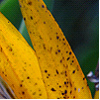 Strelitzia reginae flower
Strelitzia reginae flower
Symptoms
Fungus attacks all the above or below ground level parts of the plant living within the tissue of the plant and are very small and not normally detected until the fruiting body appears. However parasitic types such as powdery mildew or rust are visible on the outer surface of the plant.
Fungi hyphae may be divided by cross walls and known as "septate" while others with no cross walls are known as "nonseptate". These are the fungi responsible for cell leakage as in rot.
Back Mold (Chalariopsis thielavioides) affects understocks of grafted Rosa species by inhibiting the development of callus. It is whitish-grey maturing to black and can be found in the pith of the rose stem.
Black Root Rot (Chalara elegans).This recently introduced fungal disease in Australia (1993) affect plants by blackening the root systems and turning leaves yellow or purple. It is difficult to identify specifically as other pathogenic root diseases and nutritional deficiencies have simular characteristics.
The asexual spores are dispersed by wind or water. It is also transmitted on insects and in contaminated growing media or plants preferring humid moist conditions.
This fungus affects a wide range of ornamental plants including; annuals, perennials and shrubs. Examples are Begonia, Boronia, Camellia, Cyclamen, Fuchsia, Gerbera, Grevillea, Impatiens, Pansy, Petunia, Rosa species and Snapdragon.
Black Stem Rot (Pythium splendens) normally is a rot that occurs in cuttings turning the stem progressively black and shrunken. The leaves fall and the plant becomes stunted, eventually dieing.
Bleeding Necrosis (Botyosphaeria ribis) attacks and kills the inner wood causing the bark to split open and bleed sap giving it an oily appearance.
Blight (Endothia parasitica) is a serious pest of Castanea species, entering the twigs and small branches, and then progressively travelling throughout the tree killing it. It may form cankers on the base of the trunk or in the dead branches above with the amber coloured fruiting bodies pushing there way through the bark.
Copper Web ((Rhizoctonia crocorum). This fungal disease appears in defined patches causing the corms in the centre to become a black powdery mass. Corms on the outer ring of the patch that are partially infected forming a felty mass of violet threads on the corm scales. These threads extend into the soil and large sclerotia forms in the soil and on the corms. Healthy corms become infected from contaminated soil that contains mycelium and sclerotia.
Dry Rot (Phyllosticta concave) forms small circular spots that increase to a diameter of 30mm, and then becomes sunken as the cells collapse. The infected area develops minute black fruiting bodies.
Dutch Elm Disease (Ceratocystis ulmi) is a serious fungal problem of Ulmus species that initially causes yellowing then wilting of the leaves that turn brown and die. This may be seen on certain branches of the tree and on inspection under the bark the sapwood reveals brown streaks. A cross section of the affected branch displays round spots that are dark brown. This infection normally spreads quickly throughout, killing the tree in one to two seasons.
Dieback in Camellia (Glomerella cingulate) is a pathogenic fungus that infecting existing wounds such as leaf scars or mechanical damage, forming a sunken area (canker) that spreads around the stem causing die back. The affected plant has new shoots that are brown-black and the tips curl, forming a 'Shepard's Crook' appearance. The leaves also die but are persistent on the plant and the spores are found in soil or on other infected plants.
Curvularia Leaf Spot (Curvularia species) in Turf Grass. This is normally a secondary weak fungal infection that forms spots on the leaves that lengthens turning the leaves greyish. The leaf shrivels then dies and infected areas appear as weak patches in the turf. Preventive measures include minimising leaf wetness and excessive use of nitrogen fertiliser.
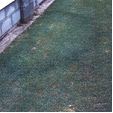 Fairy Rings Blue Couch
Fairy Rings Blue Couch 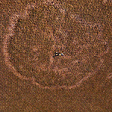
Fairy Rings are a fungal problem in Turf Grass and is caused by several species including (Lycoperdon species), (Marasmius species) and (Tricholoma species). Rings appear in the turf as fruiting bodies or dead grass and as lush green foliage. The mycelia expand radially in the turf feeding on soil nutrients and organic matter with water present.
Under severs conditions the mycelia consume all available nutrients resulting in the death of the turf. Lush turf can result from a less developed infection, where the decomposing hyphal releases nitrogen. This available nitrogen may be beneficial to the turf but some forms of nitrogen are detrimental.
Leaf Blister (Taphrina coerulescens) appears as yellowish circular raised areas on the upper side and depressions on the underside of leaves, up to 15mm across. As the fungus spreads the leaf dies but remains attached to the tree and this infection is commonly found on Quercus species..
Leaf Blotch (Guignardia aesculi) forms small or large water soaked spots that are reddish with a bright yellow margin and form black fruiting bodies in the centre. The affected leaf and petiole have a scorched appearance before falling, found on Aesculus species
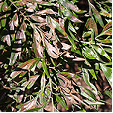 Grevillea robusta
Grevillea robusta 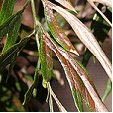 Leaf Scorch
Leaf Scorch
Leaf Scorch (Verrucispora proteacearum) is a fungal disease that infects leaves causing large parts of the leaf to turn grey-brown, giving the appearance that it has been singed by fire. Black fruiting bodies appear on the affected areas and the leaf soon withers then dies. New, mature leaves are affected during very wet periods towards the end of the branches and Grevillea and Hakea species are susceptible.
Melting Out (Helminthosporium vegans) forms bluish black spots with straw coloured centres on the leaves and may be found on the sheath, encircling it causing Foot Rot. It infects grasses particularly Poa pratensis. There is another fungus that is simular Helminthosporium Blight (Helminthosporium dictyoides) that infects Poa, Festuca and Agrostis species.
Pad decay (Aspergilus alliaceus) infects Cereus and Opuntia species and occurs at during periods of high temperature. The yellow spores at the epidermal layer through wounds and germinate on mass causing the area to become soft and spongy. An anthracnose called Shot Hole is a similar forming brownish spots the turn grey, and then black destroying pads. Control methods include physically removing damaged pads and allowing the Sun to heal wounds.
Potato Gangrene (Phoma foveate) is a soil borne fungus that infects the roots during harvest primarly through wounds and develops during storage. The potatoes rot from the inside forming rounded depressions on the surface and have a strong odour of rotten fish.
Root Rot Fungi (Phymatotrichum omnivorum) and (Pellicularia filamentosa) cause the roots to rot and the plant suddenly wilts then dies.
Root Rot (Pythium debaryanum) forms water soaked dark brown streaks that affect all parts of the plant causing wilting then dieing. It infects Ranunculus species, it also infects cactus species by forming brown spotting and wilting that appears at the base of the plant then extends towards the top. It quickly spreads from plant to plant in collections and is controlled by avoiding over watering, excessive humidity and are using a sterilised soil when potting up.
This fungus also is responsible for damping off of seedlings in a glasshouse environment.
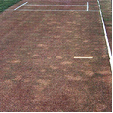 Spring Dead Spot
Spring Dead Spot 
Spring Dead Spot (Leptosphaeri species) is a fungal disease that infects Couch Grass. It first appears during autumn as pale bleaches areas up to 500mm (20in) wide and persists throughout winter. In spring the affected areas do not recover or recover slowly and on inspection the roots or rhizomes are rotted. Runners from the surrounding healthy turf will help with recovery and all signs of the problem disappear by mid summer.
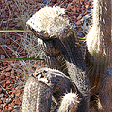 Cactus species
Cactus species 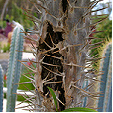 Pachypodium species
Pachypodium species
Stem Rot (Helminthosporium cactivorum) forms well defined yellow lesions that mature into soft dark brown rot. It commonly infects Cactus species entering through the stomates or wounds. Heavily infected plants collapse and die.
Stem Rot or Basal Rot (Pellicularia rolfsii) is a soil borne fungus that infects the stem root junction and extends into the leaves. In orchids the leaves become discoloured, dry and detach from the base which is covered in a fungal growth that produces sclerotia. The sclerotia is whitish to yellow then becoming dark brown and can be viable for up to four years.
White Mold (Ramularia desta f. odorati) occurs on both sides of the leaf and looks simular to powdery mildew but forms faint dull, reddish brown elongated spots on the leaf that may be depressed or along the margin where they have a watery appearance. Tufts of hyphae develop in the stomates.
Wilt (Ceratocystis fagacearum) causes leaves to curl then turn brown and the sap wood may also turn brown or black. Heavy infection may kill a tree within two seasons and is found on Quercus species and other ornamental trees.
Witches Broom may be a fungal problem that causes a proliferation of small axillary shoots to appear at the end of the branches. Little is known about this problem, though it affects a wide range of plants including Eucalyptus, Leptospermum and Pinus species.
Source and Dispersal
Fungus is found in the soil or on other infected plants and after releasing the spores, they are dispersed by wind or are transmitted in infected stock, insects and with splashing water.
Wilt is transmitted by infected root stocks, several species of insect and contaminated tools.
Dutch Elm Disease is transmitted by bark beetles such as (Scolytus multistriatus) and (Hylurgopinus rufipes). These beetles deposit eggs in the sapwood where the lava tunnel and pupate. The emerging beetles tunnel the bark and carry the fungus to fresh feeding sites on the tree. Infected beetles may also be transported to fresh sites in waist material.
Favoured Conditions
Prefers cool moist conditions with temperatures from 10º to 25ºC and is more common from autumn to spring when it is wet.
Affected Plants
A wide range of plants and all parts can be infected by various fungal diseases. Bleeding Necrosis is found in Liquidambar species and Stem Rot or Dry Rot infects Cactus species such as Opuntia and Pelargonium.
Abies species are infected by several fungi that cause Leaf Cast which turn the needles yellow to brown then fall prematurely.
Abutilon species are infected by the Stem Rot (Macrophomina phaseolin) affecting the lower stems and is not commonly seen.
Achillea, Cuphea, Leucanthemum, Euphorbia species are infected by the Stem Rot (Pellicularia filamentosa) which enters through the roots and rots the base of the stem.
Alternanthera species are infected by the Leaf Blight (Phyllosticta amaranthi) which forms small brown spots on the leaves causing them to curl and die.
Aloe, Astrophytum, Copiapoa, Echinocactus, Espostoa, Ferocactus, Gymnocalycium, Kalanchoe and Schlumbergerera species are infected by Bipolaris Stem Rot (Bipolaris cactivora). This infection affects many cacti species causing rot in the stems with a blackish appearance.
Amelanchler is affected by the Witches Broom (Apiosporina collinsii).
Antirrhinum species are infected by the Blight (Phyllosticta antirrhini) that forms light brown spots on the upper-side of the leaf and on the stem. As the spots enlarge they turn greyish with black fruiting bodies in the centre, then become brown and killing the affected areas.
Begonia species are infected by the Stem Rot (Pythium ultimum) turning stems black then becoming soft and causing the plant to collapse. This is the same fungus that causes Damping-off.
Betula species are affected by the Leaf Blister (Taphrina bacteriosperma) which curls the leaves and forms reddish blisters.
Chamaedorea and other cain-like species are infected with Gliocladium Stem Rot (Gliocladium vermoseni) which forms a dark basil stem rot generally on damaged plants and produces orange-pink spores. The mature leaves are first affected and eventually the stems or cains rot and die.
Crocus and Gladiolus species are infected by the Dry Rot (Stromatinia gladioli), which causes lesions on the corms and rots the leaf sheath.
Crocus, Iris, Tulipa, and Narcissus species are infected Copper Web ((Rhizoctonia crocorum).
Dianthus species are infected by Phialophora Wilt (Phialophora cinerescens) that causes the leaves to fade and plants to wilt. There is obvious vascular discoloration which is very dark. It is not found in Australia.
Erythrina x sykesii may be infected by the Root Rot Fungi (Phymatotrichum omnivorum).
Fern species are infected by Tip Blight (Phyllosticta pteridis). This blight produces ash-grey spots with purple brown margins and the fruiting bodies appear as black pimple like spots. It is transmitted by air or moisture and in infected fronds become brown and die. Control methods include sprang fungicide on leaves or reducing humidity and avoid wetting the fronds.
Forsythia species are infected by Stem Gall (Phomopsis species). It forms rounded growths along the stems causing them to die and look unsightly.
Gladiolus species are infected by Penicillium Rot of Corms (Penicillium gladioli). This disease forms deeply sunken reddish brown areas that become corky and produce a greenish fungal growth.
Hedera species are susceptible to several Fungal Leaf Spots including (Glomerella cingulate), (Phyllosticta concentrica) and (Ramularia hedericola). All of which cause yellowish spots that develop into dry brown blotches that kill the leaf.
Larix species are susceptible to Leaf Cast (Hypodermella laricis). This fungus attacks the needles and spur shoots turning them yellow at first then brown after which small black fruiting bodies appear on the leaves during winter.
There are several other fungi including (Cladosporium species) and (Lophodermium laricis) cause leaf blight or leaf casts.
Orchids such as Cattleya, Cymbidium, Cypripedium, Dendrobium, Epidendrum, Oncidium, Paphiopedilum, Phalaenopsis and Zygopetalum species are infected by Phomopsis Rot (Phomopsis species). This fungal problem forms a firm brown rot that appears on the leaves, pseudobulbs and rhizomes. The affected areas have yellow margins and the centre is covered in tiny black specks (fruiting bodies). Cattleya species are particularly susceptible. These plants are also infected by Psudobulb Rot (Mycolleptodiscus coloratus implicated). Dark spots appear on the pseudobulbs eventually causing extensive rot and killing the bulb.
Palms are infected by the fungus Butt Rot (Ganoderma sulcatum). The fungus entered the lower trunk normally as a result of mechanical damage (lawn mower). Symptoms include stunting of new growth and yellowing of the lower leaves. Fruiting bodies become evident at the base of the trunk. There is no effective control method and replanting in infected soil should be avoided.
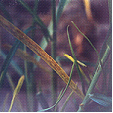 Kikuyu Yellows
Kikuyu Yellows 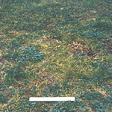
Pennisetum clandestinum (Kikuyu) is susceptible to Kikuyu Yellows (Verrucalvus flavofaciens), thisis a water mould that infects the roots and causes them to rot. The infection extends up the stem and onto the leaves with yellow discolouration and can be limited to a small or large area up to 1m (3ft) wide.
It is found in warm temperate to sub tropical regions and dispersed in infected soil or plant material. There is no chemical control, nitrogen fertiliser masks the symptoms and complete fertiliser encourages stronger roots to fight the disease.
Pittosporum, Antirrhinum, Aquilegia, Echinops and Orchid species are infected by the Stem Rot or Basal Rot (Pellicularia rolfsii) commonly in the northern hemisphere and preferring humid glasshouse conditions.
Solidago species are infected by the fungal Scab (Elsinoe solidaginis) which covers the leaves and stunts the growth of the plant. Young plants may be killed.
Trillium species are infected by the stem rot (Pellicularia rolfsii) and ( Ciborinia trillii). This normally occurs in wet soils and is detrimental to the plants life.
Tsuga species are infected by Sapwood Rot or Butt Rot (Ganoderma lucidum) and (Coniophora puteana), which attacks the sapwood close to the bark, towards the base of the tree. Commonly killing the host.
Tulipa species are affected Blue Mold (Penicillium species) and the fungus (Rhizopus stolonifer) causing rot in the bulbs.
Vinca species are infected by the soil born Root Rot (Pellicularia filamentosa) which rots the stems and roots.
Viola species may be infected with the Scab (Sphaceloma violae) which attacks all parts of the plant including the seed capsule forming yellowish spots that turn brown and in leaves fall out. Stems and petioles can be girdled killing the upper part.
Viola species are also infected with the Stem Rot (Myrothecium roridum) which attacks the stems at ground level causing them to become dry and brittle. The leaves show symptoms by turning purplish-black and this fungus also infects Alcea and Antirrhinum species.
Non-chemical Control
Generally remove and destroy any infected plants or plant parts, when replanting, avoid using susceptible species for 3 years. When growing crops space the plants to reduce the humidity and airflow and cultivate the soil to increase the drainage. Remove weed growth from around the susceptible plants.
Avoid over watering the surrounding soil which encourages fungal development. In the case of trees remove any infected branches and heavily infected trees should be cut down and removed. This infected material should be disposed or burnt. Damaged trees should have the wounds dressed and sealed as a preventative measure particularly for Dieback in Camellia.
Deter Potato Gangrene by planting clean stock and be careful not to damage the crop when weeding. When harvesting the tubers choose a dryer period and be careful not to damage them.

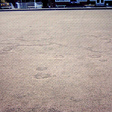 Fairy Rings
Fairy Rings
Fairy Rings in Turf are difficult to control and may appear or disappear sporadically. Cultural practice such as minimal thatch build-up, regular aeration and a reduction of organic matter spread on the turf will reduce infection.
Chemical Control
No suitable fungicides available, though drenching or spraying the soil with the fungicide dichloran helps control soil born fungi.
Note
Always read the label for registration details and direction of use prior to application of any chemicals.
Average Lowest Temperature : -10º C 14º F
USDA : 4, 5, 6, 7, 8,
This USDA (United States Department of Agriculture) hardiness zone chart can be used to indicate a plant’s ability to withstand average minimum temperatures. However, other factors such as soil type, pH, and moisture, drainage, humidity and exposure to sun and wind will also have a direct effect on your plant’s survival. Use this chart only as a guide, always keep the other factors in mind when deciding where, when and what to plant.
A plant's individual USDA zone can be found in the Plant Overview.
Climate Description
Cool to Cold
These zones have low winter temperatures with moderate humidity and moderate summer temperatures.
Frosts and snow are severe. Droughts rarely occur and wind is cold.
Plant growth
Endemic native and exotic cool climate plants grow well within these zones.
| Dictionary | Growth Habit |
| Leaf Type | Botanic Flower Description |
| Leaf Shape | Flower Inflorescence |
| Leaf Arrangement | Fruit Type |
| Leaf Margin | Bark Type |
| Leaf Apex And Bases | Flower Description |